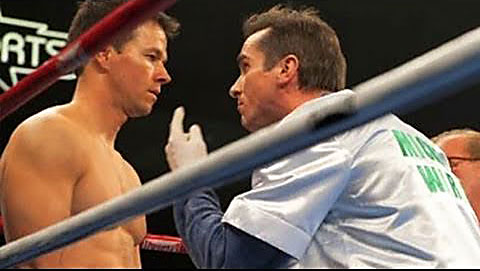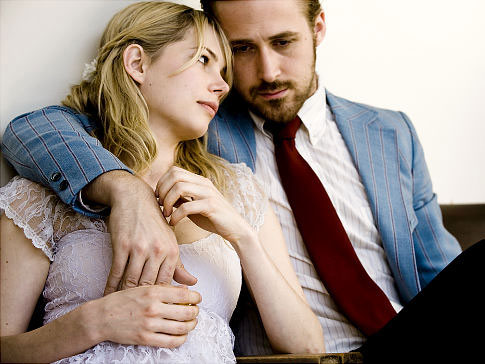|
My father had a phrase: "rougher than a cob." He used it to describe people he knew whose language and manners came straight from the barnyard. As often as not, he used the term with affection, and the people he described that way were his friends. In the rural part of Ohio where he and I grew up, most collars were blue, and so was a fair amount of the language. My dad knew well that rough manners and good hearts go together a lot more often than many people assume.
Dad wouldn't have had much liking for most of the characters in The Fighter, David O. Russell's new film. In fact, it's a movie he would have loathed; rough people he could make allowances for, but not rough movies. Nevertheless, I found myself thinking of the phrase "rougher than a cob" when considering fighter Micky Ward (Mark Wahlberg), his large family, and his neighbors in that bluest of blue-collar towns, Lowell, Massachusetts. Based on a true story, The Fighter represents an extreme version of the working-class experience, and it has some interesting things to say about the hearts that beat under rough, even threatening exteriors.
At the film's beginning, Micky is a boxer who can't get a break, though not for lack of trying. His bottle-blond, chain-smoking mother Alice (Melissa Leo) is his manager, and she directs most of her attention to her son Dicky Edlund (Christian Bale), Micky's elder half-brother and sparring partner. Dicky's claim to fame is having once defeated Sugar Ray Leonard, and he's still a hero in Lowell, strutting down the main street surrounded by fans, Micky in tow. Most of the locals don't choose to acknowledge that Dicky has become a crackhead and a major screw-up, living in a crack house and in constant trouble with the law.
 |
The bouts Alice arranges for Micky tend to go wrong; a major fight in Las Vegas, in which Micky is heavily favored, suddenly turns sour when Micky's scheduled opponent gets sick and is replaced with a boxer in a higher weight class. Dicky, to put it mildly, doesn't help. He's a great sparring partner for Micky when he actually shows up at the gym, which is something Micky learns not to count on. Dicky's drug-fueled grandstanding and chisel-brained schemes—he thinks a fake-prostitution scam is a perfectly acceptable way to earn money—keep him in and out of jail. The documentary being filmed about Dicky's life, which he thinks celebrates his comeback, is in fact about something else entirely, and its airing on HBO is the most painful event in the movie.
In the midst of this turmoil, Micky meets Charlene (Amy Adams), a tough-talking barmaid who sees what Micky's family is doing to him and tries to break their hold on him. Soon Charlene is fighting the family for Micky's soul, and it becomes apparent that neither side can win: if Charlene has the best ideas about Micky's career, Dicky is the one who knows the winning strategies in the ring. Can a truce be called?
The Fighter is an honorable entry in the boxing movie genre, with lots of exciting action in the ring and a compelling story out of it. The performances, in particular, are admirable. Bale, a masterful actor who hasn't always chosen his roles well, has found the role of a lifetime here. Painfully gaunt, he careens through the film's first half as Dicky, his athlete's cockiness amplified by constant drug-fueled euphoria. He is equally impressive in the second half, when he is forced to face what he's become and either change or die. Leo is amazing as Alice, who dominates everyone around her through sheer ferocity, and Adams more than holds her own playing a character that is much more abrasive, but no less good-hearted, than her usual roles.
Bale, Leo and Adams together are so dazzling that it's sometimes hard to remember Wahlberg's Micky is the film's central character. This is too bad, because Wahlberg's acting is just as fine as that of his co-stars; his character is simply quieter. A lot of critics have disagreed with me on this, especially Roger Ebert, who found Wahlberg's performance (in his words) "flat and withdrawn." Personally, I found it subtle and moving.
I had no trouble with Wahlberg; I had a lot with Micky and Dicky's seven raunchy, undifferentiated sisters, who function as a combined Greek chorus, Monty Python sketch and gang of mob enforcers. These are seven sisters who couldn't even spell the names of colleges, and The Fighter veers uncomfortably close to self-parody every time they appear.
Nevertheless, at their best the characters in The Fighter demonstrate the better side of the "rougher than a cob" equation. Micky might make love with his socks on, and both he and Charlene might use the f-word in every sentence, but there's no question that hearts of gold beat under those sandpaper exteriors. The same eventually is revealed about Dicky, Alice and even the seven egregious sisters, so that the final, "Rocky"-style triumph, in a boxing ring in London, is a victory everyone in the audience can savor.
There are no triumphs to savor in Derek Cianfrance's Blue Valentine, except for those Ryan Gosling and Michelle Williams score in their performances. The disintegration of the marriage of Dean (Gosling) and Cindy (Williams) is a far more usual blue-collar experience than depicted in The Fighter, and far more depressing.
Dean and Cindy's lives have been rougher than a mountain of corncobs, and this, Cianfrance shows us, is what eventually destroys their relationship. The trailer for Blue Valentine depicts the one truly sweet moment in the film: Dean strums his ukulele and yodels "You Always Hurt the One You Love," and Cindy dances a softshoe to his song. This is the exact moment when Dean and Cindy, who have known each other only a short time, fall in love. Cianfrance—who tells the story in non-linear fashion—follows immediately with the exact moment, six years later, when Cindy, at least, falls out of love: a joyless encounter in a spaceship-themed "adult motel" that Dean thought would put the spark back in their marriage. (Gosling and Williams are both emotionally and literally naked in Blue Valentine; the movie barely escaped a dreaded NC-17 rating.)
 |
Cianfrance encouraged Gosling and Williams to improvise much of their dialogue, and they rewarded him with performances of heart-piercing directness and depth of feeling. The audience is left to assemble, jigsaw-like, the clues of how and why Dean and Cindy's marriage went bad. We see that Cindy is smarter and more ambitious than Dean, and that Dean likes his liquor. ("You have a job where you have to drink before you go to work in the morning!" Cindy says at one point. Dean corrects her: "I have a job where I can drink before I go to work in the morning!") We see Dean reacting badly to Cindy telling him she saw an old boyfriend at the supermarket; much later, we see he has good reason to hate this particular boyfriend. We see that Cindy's home life before her marriage was miserable, and learn that Dean's was even worse. We see that both are unwise in sadly predictable ways, and make bad choices for themselves and each other.
At the end, all the pieces fit together to make Dean and Cindy's final, horrible confrontation seem inevitable. Dean and Cindy's lives are scarred by pain and misfortune; their tragedy is that their greatest misfortune was marrying each other. Though not exactly a pleasurable film, Blue Valentine is a moving, unsettling portrait of a failed marriage.
Note to readers: I had intended by now to write a review of the Coen Brothers' True Grit, which is—as other critics have noted—less a remake of the 1969 Henry Hathaway-John Wayne version than a reconsideration of Charles Portis' original novel. (John Wayne, incidentally, was my father's favorite actor.) Unfortunately, to review the new version fairly I would have to see the old one again, and in the twenty-four hours between my moving the Duke's True Grit to the top of my Netflix list and the time to mail my next disk, the availability of that film went from "Now" to "Very Long Wait." After more than a month, I am still waiting. (Yes, I know AMC recently rebroadcast the original True Grit several times, but two years ago Comcast gave me the thoughtful little gift of removing AMC from my cable package.)
So, rather than rely on my forty-two-year-old memories of the first film, I will simply say the Coen Brothers' version is lean, tough, and closer to the book than the original. Jeff Bridges is obviously having fun as Rooster Cogburn—playing him as a cross between Woodrow Call and Dude Lebowski—and Hallie Steinfeld, a likable, highly skilled young actress, is much more age-appropriate to the role of Mattie Ross than Kim Darby in the first film. Josh Brolin is a persuasively loathsome snake as the murderous Tom Chaney, and Matt Damon—who has quietly become Hollywood's Most Underrated Actor—is properly, hilariously pompous as Ranger LaBoeuf. (I remember Glen Campbell's performance as LaBoeuf as one of the worst I have ever seen, but I will say no more pending the arrival of the original True Grit in my mailbox.)
|

